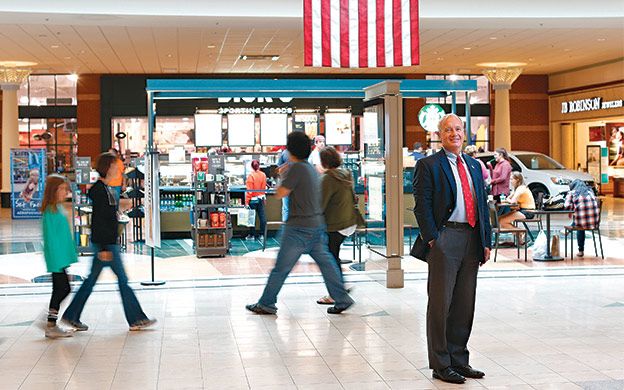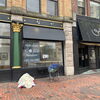Processing Your Payment
Please do not leave this page until complete. This can take a few moments.
As retail trends shift, the Bangor Mall adjusts by being more nimble
On a given day, Ao Pineda is at her new store, Ao Luxe in the Bangor Mall, providing body-art services like the application of henna and threading, followed by an evening of bellydance instruction.
Where regional malls were once the domain of fashion brands and national chains, they're now adapting to shifting retail trends and consumer demographics. As such, they're reaching out to non-traditional retailers. The Bangor Mall, owned by Indianapolis-based Simon Property Group, reflects that trend. Body-art services, a church and a fitness studio are part of a new wave of non-traditional tenants moving into the mall.
“Retail has changed,” says Bangor Mall General Manager James Gerety. “What we're offering is changing, because that's what the customer wants and you have to adapt. We're looking for new and exciting concepts. And it's not particular to the Bangor Mall. It's industrywide.”
The movement is a reflection of trends nationally, as malls and shopping centers grapple with the decline of venerable brick-and-mortar retailers like Macy's and Sears, along with the growing popularity of online shopping and shifting shopper demographics that see less spending by downsizing baby boomers and a shift in types of spending by millennials who may prefer experience over goods.
In Pineda's case, she moved Ao Luxe from a cramped studio in downtown Bangor, where storefront services shared space with the dance studio. At Bangor Mall, she has double the floor space, and takes a store once occupied by the national chain Motherhood Maternity. She now benefits from having better visibility and foot traffic, among other features.
“It's so much better,” Pineda — a cheerful person who is a personal advertisement of her services — says, as the mall corridors hummed with shopping activity. “The parking is amazing. The security is amazing: My other studio was broken into at least twice a year. The management is amazing. There's air conditioning. Our classes are fuller. There's more traffic exposure. It's been very successful.”
Shifts in big retail
One major change here occurred in January, with the closure of Macy's. The 160-year-old chain opened here in 2006, in a section constructed in 1998 for a Filene's (now a web retailer). The Macy's closure was one of 68 announced in January, due to declining store traffic, in order to focus on new marketing strategies like online buying and mobile-enabled shopping, according to a Macy's press release. CBRE|The Boulos Co. broker Charles Day says he is brokering the property. On Loopnet, Macy's is listed as 143,000 square feet on two floors, with the possibility of dividing it into pieces as small as 30,000 square feet, and an introductory rental rate listed at $5 per square foot.
Macy's was one of the big-four anchors. The three remaining are J.C. Penney, Sears and Dick's Sporting Goods. But there's still some flux. Earlier this year, Sears' parent, Sears Holdings Corp., announced the closure of 42 Sears stores and 108 Kmarts, due to “continued softness in store traffic and elevated price competition.” The Bangor Mall's Sears was spared, although a nearby Kmart, which is not in the Bangor Mall, was closed in April.
Smaller stores have closed or moved, too. The last permanent tenant in what is now Ao Luxe was Motherhood Maternity, followed by several temporary tenants.
Changing the retail landscape
Tackling this shifting landscape and, at times, revolving-door vacancies, the Bangor Mall is pursuing a variety of strategies, says Gerety.
Strategies include:
- Recruit non-traditional tenants offering “experience” over wares
- Recruit tenants that are proven draws, like Starbucks as a brand, and bridal goods as a niche
- Work closely with tenants to configure and furnish spaces for their needs
- Leverage digital media to enhance customer and tenant interaction
- Promote a welcoming atmosphere, with perks like comfy corridor seating to hang out
- Explore further experiential and tech-savvy options to suit preferences of millennials, currently rising to their peak spending power.
Evolution is necessary — and exciting, says Gerety.
“Part of what customers want is the newest and latest,” he says. “If we did not address that particular want and need, then we're not listening to our customers.”
Mall-pocalypse?
The fortunes of the Bangor Mall — and Maine malls in general — reflect national trends, says University of Maine Professor of Economics Jim McConnon.
“There's opportunity for malls to reinvent themselves and look at the ways in which they can better meet the needs of customers,” McConnon says. “That will involve being a little more customer-focused in terms of knowing the customer base and what their needs are.”
McConnon identifies some trends that impact malls:
- The shift to online shopping challenges anchor stores nationally. Malls traditionally relied on anchors to draw traffic.
- Since World War II, too much retail space was created, compared with demand, especially given e-commerce trends.
- Shopper demographics have changed: Millennials now outnumber baby boomers and are moving into peak spending years. Also, millennials prefer close-to-home shopping over distant shopping centers, and are more likely to shop online and use apps than baby boomers.
With regard to e-commerce, it's relatively small but growing, says McConnon. In 2011, overall national retail sales (including sectors like auto and energy) were $4.1 trillion; of that, $200 billion, or 4.9%, was e-commerce-related. In 2016, national retail sales were $4.9 trillion; e-commerce accounted for $391 billion, or 8%.
While e-commerce isn't going away, it doesn't mean the death of the mall, he says.
“It's going to lead to a variety of changes,” McConnon says. “Folks who are innovative in responding to those changes, and to demographic changes, will be the ones who survive. We'll still have malls. But like everything else in the economy, there have to be adjustments. There might be different things going on — different kinds of shops, different uses of technology and innovation — to be relevant to future consumers.”
Writing in June for Forbes, Dallas retail consultant Steve Dennis sees plenty of opportunity. In fact, he says, the loss of underperforming anchors can create new, more profitable opportunities.
“This is not to say that some malls won't die a painful death, never to return from the ashes,” Dennis writes. “But the apocalyptic vision painted by some is far from accurate. Most high-end malls will continue to thrive with an approach that looks rather familiar. Many others will evolve to be quite different, but will remain far from hurting, much less dead. Others will be radically transformed to something with a vastly higher and better use. Either way, with few exceptions, investors, customers and employees are going to be just fine.”
Non-traditional
At the Bangor Mall, other tenants that are part of the evolution are Sunshine Fitness Studio and Wellness Center, occupying a former women's apparel store, and CityReach Church.
Since its founding in 2014, the church had various locations before settling at the mall, says its pastor, Seth Dee.
“We were looking everywhere. Then we discovered there was empty space at the mall,” says Dee.
The sanctuary and children's room initially took two spaces at opposite ends of the mall, one vacated in early 2016 by New York & Co. Recently, the church moved to neighboring spaces vacated by a yoga and wellness center and a furniture store.
Dee sees the mall as potentially permanent: “We know it's really different. Churches don't usually meet in a mall. But the way we see it is that the church is the people, not the building.”
With her fitness services spread to date throughout Greater Bangor, Sunshine Gannucelli relocated much of her eponymous business to the mall to streamline efficiencies both for herself and for clients.
“The modern customer needs functionality — 'I've got to get my workout in and I've got to run my errands,'” she says. “The idea was to come to a centrally located area, where people already have to be.”
Her studio's relationship with the mall is symbiotic, she says.
“It provides a lot of foot traffic for the mall that they might not already have,” she says. “My clients are walking past these windows, getting to and from their cars. They'll eyeball the windows and it might spark an interest to get something they saw.”
Finding tenants like these means sending out the mall's specialty leasing representative and providing temporary leasing to see if the mall is a good fit, says Gerety. Out in the market looking for prospective tenants, the representative “knocks on doors, goes to trade shows, goes to other communities to say, 'Listen, we have an opportunity in Bangor. In some cases, it's, 'Wow, we'd like to talk.'”













Comments